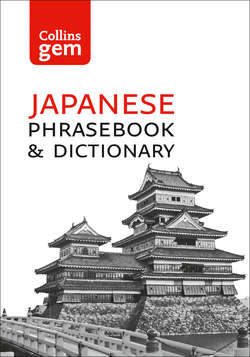Читать книгу Collins Gem - Collins Dictionaries - Страница 7
ОглавлениеPronouncing Japanese
Although the Japanese writing system is rather complicated, pronouncing Japanese is easy once you know the few basic rules. This book has been designed so that as you read the pronunciation of the phrases, you can follow the Japanese. This will help you to recognize the different sounds and give you a feeling for the rhythm of the language. Below are a few rules for you to note.
In Japanese the basic unit of speech is the syllable. Each syllable is pronounced approximately the same length and rather flatly. Japanese has a pitched accent (high and low) but syllables do not have tones as they do in Chinese. It is more important not to stress any one part of a word. For example, in English the word Paris is pronounced paris and in French paree. Japanese gives equal strength to both syllables: pari.
Japanese has relatively few sounds. Each vowel has only one sound.
Japanese vowels
| Japanese | sounds like | example |
| a | a | bath |
| i | i | police |
| u | u | put |
| e | e | let |
| o | o | got |
Long vowel sounds
| aa, ii, uu, ee, oo | approximately double the length of other syllables |
15 basic consonants
k, s, sh, t, ts, ch, n, h, m, y, r, w, g, z, d, b, p, n/m Each consonant is followed by one vowel to create a syllable as in
| ki-mo-no | traditional Japanese costume |
| Ta-na-ka | Japanese surname |
These consonants are close to their English equivalents but note the following:
g is pronounced as in golf, not as in Germany y is pronounced as in young, not as in cry.
The consonant n/m, which appears at the end of the list above, counts as a syllable in its own right. It is pronounced like the nasal n in sing when it appears at the end of words, e.g. en ‘yen’, and before most other sounds, e.g. onsen ‘hot spring’. Before p, b and m, it sounds more like m and is therefore written here as m, e.g. shimbun ‘newspaper’. When n appears before a vowel or y, it is written as n’ to distinguish it from the syllables beginning with n, e.g. kin’en ‘non-smoking’ compared with kinen ‘commemoration’.
Since Japanese lacks the consonants l and v, foreign loanwords with these letters are pronounced with r and b, respectively. Thus, English words ‘love’ and ‘rub’ both become indistinguishable as ra-bu in Japanese.
Japanese also lacks the si sound (as in ‘to sit’): shi is used instead, sometimes with embarrassing results! Other English sounds that do not exist in Japanese are hu (as in ‘hook’: fu is used instead); th (as in ‘thin’: shi is used instead); and ti (as in ‘tin’: chi is used instead).
Double consonants kk, pp, ss and tt are written before a vowel, which indicates a pause equivalent to one syllable in length before that consonant. The sound before the pause tends to become sharper than at other times.
| Japanese | Pronunciation | Meaning |
| kitte | ki (pause) te | stamp |
| kippu | ki (pause) pu | ticket |
ki, shi, chi, ni, hi, mi, ri, gi, ji, bi and pi sounds can be combined with ya, yu or yo to create combined syllables. For example, ki + ya become kya, ki + yu become kyu and ki + yo become kyo. Examples of this can be found in the words Tookyoo and Kyooto, where the combined syllable is pronounced as two sounds, but said very quickly with the same length as one syllable.
| Japanese | Pronunciation | Meaning |
| matchi | ma (pause) chi | match |
In the case of the chi syllable, a double consonant sound is written as tchi as in the example above.
You should also remember that Japanese does not have a silent e at the end of a word such as in the English ‘to take’. If ‘take’ is read as the Japanese word take (bamboo), it should be pronounced tah-keh. Similarly sake (rice wine), is pronounced sah-keh, etc.
However, the vowel u at the end of a word such as desu will sound very weak.
